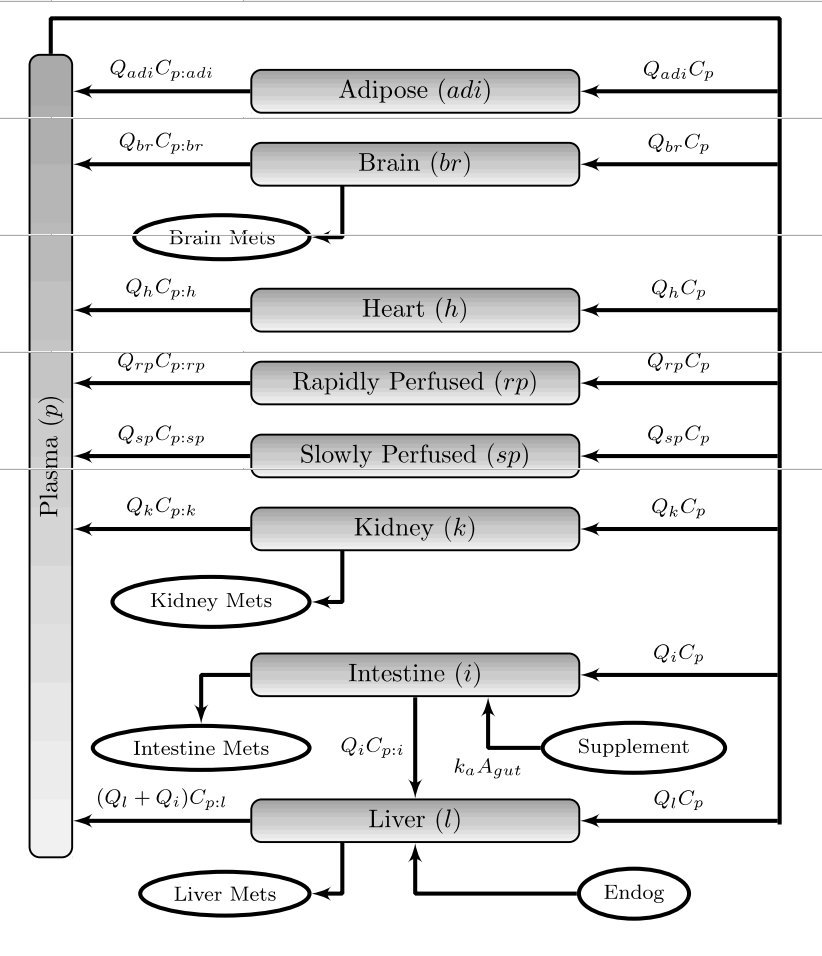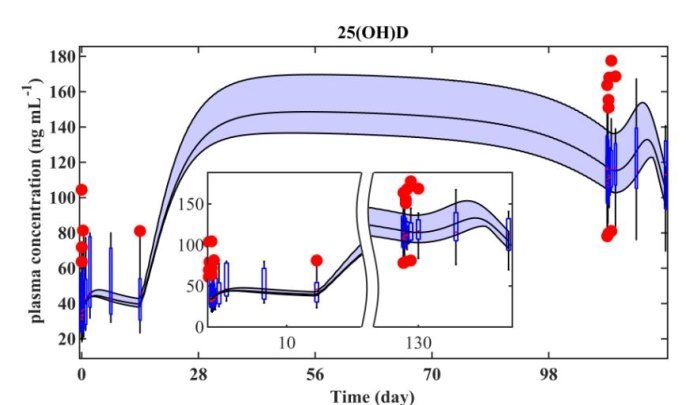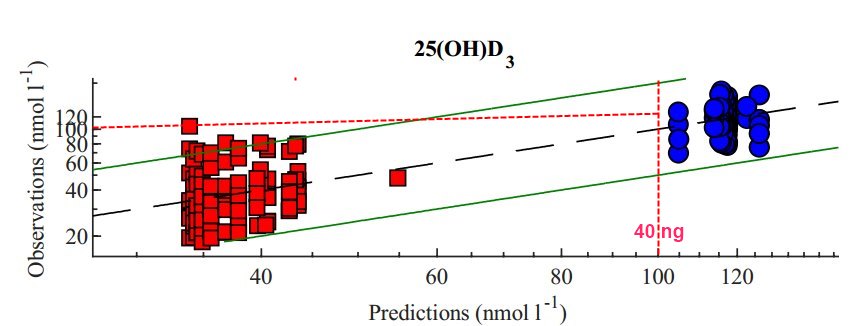Model of Vitamin D and metabolites reaction to 5,000 IU daily
Physiologically Based Pharmacokinetic Modeling of Vitamin D 3 and Metabolites in Vitamin D-Insufficient Patients
Drug Metab Dispos. 2022 Sep;50(9):1161-1169 doi: 10.1124/dmd.121.000609
Colton W Sawyer 1 , Stacey M Tuey 2 , Raymond E West 3rd 2 , Thomas D Nolin 2 , Melanie S Joy 2



A physiologically based pharmacokinetic (PBPK) model of vitamin D3 and metabolites [25(OH)D3, 1,25(OH)2D3, and 24,25(OH)2D3] is presented. In this study, patients with 25(OH)D3 plasma concentrations below 30 ng/ml were studied after a single dose of 5000 I.U. (125 µg) cholecalciferol, provided with 5000 I.U. daily cholecalciferol supplementation until vitamin D replete [25(OH)D3 plasma concentrations above 30 ng/ml], and had serial plasma samples were collected at each phase for 14 days. Total concentrations of vitamin D3 and metabolites were measured by ultra-high performance liquid chromatography tandem mass spectrometry. A nine-compartment PBPK model was built using MATLAB to represent the triphasic study nature (insufficient, replenishing, and sufficient). The stimulatory and inhibitory effect of 1,25(OH)2D3 were incorporated by fold-changes in the primary metabolic enzymes CYP27B1 and CYP24A1, respectively. Incorporation of dynamic adipose partition coefficients for vitamin D3 and 25(OH)D3 and variable enzymatic reactions aided in model fitting. Measures of model predictions agreed well with data from metabolites, with 97%, 88%, and 98% of the data for 25(OH)D3, 24,25(OH)2D3, and 1,25(OH)2D3, respectively, within twofold of unity (fold error values between 0.5 and 2.0). Bootstrapping was performed and optimized parameters were reported with 95% confidence intervals. This PBPK model could be a useful tool for understanding the connections between vitamin D and its metabolites under a variety of clinical situations.
SIGNIFICANCE STATEMENT: This study developed a physiologically based pharmacokinetic (PBPK) model of vitamin D3 and metabolites for patients moving from an insufficient to a repleted state over a period of 16 weeks.
📄 Download the PDF from VitaminDWiki
VitaminDWiki is confused
They state that 5,000 IU was given until >30ng . but it seems that most started higher than 30ng
Do not know what the blue lines and red dots represent - cannot find a caption
The final PDF costing $35 for the next 12 months may eliminate the confusion
References
Abbas MA (2017) Physiological functions of vitamin D in adipose tissue. J Steroid Biochem Mol Biol 165:369381.
Abramson FP (1986) Kinetic models of induction: II. decreased turnover of a product or its precursor. J Pharm Sci 75:229-232.
Arendse L, Blundell T, and Blackburn, J (2013) Combining in silico protein stability calculations with structure- function relationships to explore the effect of polymorphic variation on cytochrome P450 drug metabolism. Curr Drug Metab 14:745-763.
Armas LA, Hollis BW, and Heaney RP (2004) Vitamin D2 is much less effective than vitamin D3 in humans. J Clin Endocrinol Metab 89:5387-5391.
Bailie GR and Johnson CA (2002) Comparative review of the pharmacokinetics of vitamin D analogues. In Seminars in Dialysis, Vol. 15, pp. 352-357. Wiley Online Library.
Battault S, Whiting SJ, Peltier SL, Sadrin S, Gerber G and Maixent JM (2012) Vitamin D metabolism, functions and needs: from science to health claims. Eur JNutr 52:429-441.
Benaboud S, Urien S, Thervet E, Prie D, Legendre C, Souberbielle JC, Hirt D, Friedlander G, Treluyer JM, and Courbebaisse M (2013) Determination of optimal cholecalciferol treatment in renal transplant recipients using a population pharmacokinetic approach. Eur J Clin Pharmacol 69:499-506.
Best CM, Riley DV, Laha TJ, Pflaum H, Zelnick LR, Hsu S, Thummel KE, Foster-Schubert KE, Kuzma JN, Cromer G, Larson I, Hagman DK, Heshelman K, Kratz M, de Boer IH, and Hoofnagle AN (2020) Vitamin D in human serum and adipose tissue after supplementation. Am J Clin Nutr 113:83-91.
Bikle D, Halloran B, Gee E, Ryzen E, and Haddad J (1986) Free 25-hydroxyvitamin D levels are normal in subjects with liver disease and reduced total 25-hydroxyvitamin D levels. J Clin Invest 78:748.
Bikle DD, Patzek S, and Wang Y (2018) Physiologic and pathophysiologic roles of extra renal CYP27B1: Case report and review. Bone Reports 8:255-267.
Cheng J, Levine M, Bell N, Mangelsdorf D, and Russell D (2004) Genetic evidence that the human CYP2R1 enzyme is a key vitamin D 25-hydroxylase. Proc Natl Acad Sci USA 101:7711-7715.
Cianferotti L and Marcocci C (2012) Subclinical vitamin D deficiency. BestPract Res Cl En 26:523-537.
Davies B and Morris T (1993) Physiological parameters in laboratory animals and humans. Pharm Res 10:10931095.
Dawson-Hughes B, Heaney RP, Holick MF, Lips P, Meunier PJ, and Vieth R (2005) Estimates of optimal vitamin D status. Osteoporos Int 16:713-716.
Fassio A, Adami G, Rossini M, Giollo A, Caimmi C, Bixio R, Viapiana O, Milleri S, Gatti M, and Gatti D (2020) Pharmacokinetics of oral cholecalciferol in healthy subjects with vitamin D deficiency : a randomized open- label study. Nutrients 12:1553.
Ganji V, Zhang X, and Tangpricha V (2012) Serum 25-hydroxyvitamin D concentrations and prevalence estimates of hypovitaminosis D in the US population based on assay-adjusted data. J Nutr 142:498-507.
Gao C, Bergagnini-Kolev MC, Liao MZ, Wang Z, Wong T, Calamia JC, Lin YS, Mao Q, and Thummel KE (2017) Simultaneous quantification of 25-hydroxyvitamin D3-3-sulfate and 25-hydroxyvitamin D3-3- glucuronide in human serum and plasma using liquid chromatography-tandem mass spectrometry coupled with DAPTAD-derivatization. J Chromatogr B 1060:158-165.
Haq A, Wimalawansa SJ, Pludowski P, and Al Anouti F (2018) Clinical practice guidelines for vitamin D in the United Arab Emirates. J Steroid Biochem Mol Biol 175:4-11.
Heaney RP, Horst RL, Cullen DM, and Armas LA (2009) Vitamin D3 distribution and status in the body. J Am Coll Nutr 28:252-256.
Heaney RP, Armas LA, Shary JR, Bell NH, Binkley N, and Hollis BW (2008) 25-hydroxylation of vitamin D3: relation to circulating vitamin D3 under various input conditions. Am J Clin Nutr 87:1738-1742.
Holick MF (2006) Resurrection of vitamin D deficiency and rickets. J Clin Invest 116:2062-2072. Downloaded from dmd.aspetjournals.org at ASPET Journals on September 3, 2022
Holick MF (2007) Vitamin D deficiency. N Engl J Med 357:266-28
Holick MF, Biancuzzo RM, Chen TC, Klein EK, Young A, Bibuld D, Reitz R, Salameh W, Ameri A, and Tannenbaum AD (2008) Vitamin D2 is as effective as vitamin D3 in maintaining circulating concentrations of 25- hydroxyvitamin D. J Clin Endocrinol Metab 93:677-681.
Holick MF, Binkley NC, Bischoff-Ferrari HA, Gordon CM, Hanley DA, Heaney RP, Murad MH, and Weaver CM (2011) Evaluation, treatment, and prevention of vitamin D deficiency: an Endocrine Society clinical practice guideline. J Clin Endocrinol Metab 96:1911-1930.
Hsieh NH, Reisfeld B, Bois FY, and Chiu WA (2018) Applying a global sensitivity analysis workflow to improve the computational efficiencies in physiologically-based pharmacokinetic modeling. Front Pharmacol 9:588.
Hsu S, Zelnick LR, Lin YS, Best CM, Kestenbaum B, Thummel KE, Rose LM, Hoofnagle AN, and de Boer IH (2021) Differences in 25-hydroxyvitamin D clearance by eGFR and race: A pharmacokinetic study. J Am Soc Nephrol 32:188-198.
Ilahi M, Armas LA, and Heaney RP (2008) Pharmacokinetics of a single, large dose of cholecalciferol . Am J Clin Nutr 87:688-691.
Inouye K and Sakaki T (2001) Enzymatic studies on the key enzymes of vitamin D metabolism; 1a-hydroxylase (CYP27B1) and 24-hydroxylase (CYP24). Biotechnol Annu Rev. doi: 10.1016/S1387-2656(01) 070375.
Jernigan P and Andress DL (2003) Vitamin D analogs in uremia: integrating medical and nutritional issues. Adv Ren Replace Ther 10:241-247.
Jetter A, Egli A, Dawson-Hughes B, Staehelin HB, Stoecklin E, Goessl R, Henschkowski J, and Bischoff-Ferrari HA (2014) Pharmacokinetics of oral vitamin D3 and calcifediol. Bone 59:14-19.
Jones G, Prosser DE, and Kaufmann M (2018) The activating enzymes of vitamin D metabolism (25-and 1a- hydroxylases) In Vitamin D, pp. 57-79. Elsevier.
Kimura Y, Nakayama M, Kuriyama S, Watanabe S, Kawaguchi Y, and Sakai O (1991) Pharmacokinetics of active vitamins D3, 1 alpha-hydroxyvitamin D3 and 1 alpha, 25-dihydroxyvitamin D3 in patients on chronic hemodialysis. Clin Nephrol 35:72-77.
Leow JWH and Chan ECY (2019) Atypical michaelis-menten kinetics in cytochrome P450 enzymes: A focus on substrate inhibition. Biochem Pharmacol 169.
Leow JWH, Verma RK, Lim ABH, Fan H, and Chan ECY (2021) Atypical kinetics of cytochrome P450 2J2: Epoxidation of arachidonic acid and reversible inhibition by xenobiotic inhibitors. Eur J Pharm Sci 164:105889.
Levine BS and Song M (1996) Pharmacokinetics and efficacy of pulse oral versus intravenous calcitriol in hemodialysis patients. J Am Soc Nephrol 7:488-496.
Mawer E, Backhouse J, Holman C, Lumb G and Stanbury S (1972) The distribution and storage of vitamin D and its metabolites in human tissue. Clin Sci 43:413-31.
McNally K, Cotton R, and Loizou G (2011) A workflow for global sensitivity analysis of PBPK models. Front Pharmacol 2:31.
Meekins ME, Oberhelman SS, Lee BR, Gardner BM, Cha SS, Singh RJ, Pettifor JM, Fischer PR, and Thacher T (2014) Pharmacokinetics of daily versus monthly vitamin D3 supplementation in non-lactating women. Eur J Clin Nutr 68:632-634.
Morris MD (1991) Factorial sampling plans for preliminary computational experiments. Technometrics 33:161174.
Munns CF, Shaw N, Kiely M, Specker BL, Thacher TD, Ozono K, Michigami T, Tiosano D, Mughal MZ, Makitie O et al. (2016) Global consensus recommendations on prevention and management of nutritional rickets. Horm Res Paediat 85:83-106.
Noh K, Yang QJ, Sekhon L, Quach HP, Chow EC, and Pang KS (2020) Noteworthy idiosyncrasies of 1a, 25- dihydroxyvitamin D3 kinetics for extrapolation from mouse to man: Commentary. Biopharm Drug Dispos 41:126-148.
Ocampo-Pelland AS, Gastonguay MR, French JF, and Riggs MM (2016) Model-based meta-analysis for development of a population-pharmacokinetic (PPK) model for vitamin D3 and its 25OHD3 metabolite using both in- dividual and arm-level data. JPharmacokinet Pharmacodyn 43:191-206.
Ocampo-Pelland AS, Gastonguay MR, Riggs MM (2017) Model-based meta-analysis for comparing vitamin D2 and D3 parent-metabolite pharmacokinetics. J Pharmacokinet Pharmacodyn 44:375-388.
Pérez-Lopez FR, Brincat M, Erel CT, Tremollieres F, Gambacciani M, Lambrinoudaki I, Moen MH, Schenck- Gustafsson K, Vujovic S, Rozenberg S et al. (2012) EMAS position statement: vitamin D and postmenopausal health. Maturitas 71:83-88.
Pianosi F, Sarrazin F, and Wagener T (2015) A Matlab toolbox for global sensitivity analysis. Environ Model Softw 70:80-85.
Pludowski P, Karczmarewicz E, Bayer M, Carter G, Chlebna-Sokol D, JCzech-Kowalska J, Dçbski R, Decsi T, Dobrzanska A, Franek E, et al. (2013) Practical guidelines for the supplementation of vitamin D and the treatment of deficits in Central Europe - recommended vitamin D intakes in the general population and groups at risk of vitamin D deficiency. Endokrynol. Pol., 64:319-327
Quach HP, Yang QJ, Chow EC, Mager DE, Hoi SY, and Pang KS (2015) PKPD modelling to predict altered disposition of 1a,25-dihydroxyvitamin D3 in mice due to dose-dependent regulation of CYP27B1 on synthesis and CYP24A1 on degradation. Br J Pharmacol 172:3611-3626.
Ramakrishnan V, Yang QJ, Quach HP, Cao Y, Chow EC, Mager DE, and Pang KS (2016) Physiologically-based pharmacokinetic-pharmacodynamic modeling of 1a, 25-dihydroxyvitamin D3 in mice. Drug Metab Dispos 44:189-208.
Rizzoli R, Boonen S, Brandi ML, Bruyère O, Cooper C, Kanis JA, Kaufman JM, Ringe J, Weryha G, and Reginster JY (2013) Vitamin D supplementation in elderly or postmenopausal women: a 2013 update of the 2008 recommendations from the European Society for Clinical and Economic Aspects of Osteoporosis and Osteoarthritis (ESCEO). Curr Med Res Opin 29:305-313.
Ross AC (2011) The 2011 report on dietary reference intakes for calcium and vitamin D. Public Health Nutr. 14:938-939.
Ross A, Taylor C, Yaktine A, and Del Valle H (2011) Dietary reference intakes for calcium and vitamin D. Natl Academy Pr.
Roth DE, Al Mahmud A, Raqib R, Black RE, and Baqui AH (2012) Pharmacokinetics of a single oral dose of vitamin D3 (70,000 IU) in pregnant and non-pregnant women. Nutr J 11:1-15.
Sakaki T, Kagawa N, Yamamoto K, and Inouye K (2005) Metabolism of vitamin D3 by cytochromes P450. Front Biosci 10:119-134.
Sawyer ME, Tran HT, and Evans MV (2017) A physiologically based pharmacokinetic model of vitamin D. J Appl Toxicol 37:1448-1454.
Schuster I (2011) Cytochromes P450 are essential players in the vitamin D signaling system. Biochim Biophys Acta, Proteins Proteomics 1814:186-199.
Sheiner LB and Beal SL (1981) Some suggestions for measuring predictive performance. J Pharmacokinet Biopharm 9:503-512.
Shinkyo R, Sakaki T, Kamakura M, Ohta M, and Inouye K (2004) Metabolism of vitamin D by human microsomal CYP2R1. Biochem Biophys Res Commun 324:451-457.
Society GN (2012) New reference values for vitamin D.
Soulis-Liparota T, Cooper M, Papazoglou D, Clarke B, and Jerums G (1991) Retardation by aminoguanidine of development of albuminuria, mesangial expansion, and tissue fluorescence in streptozocin-induced diabetic rat. Diabetes 40:1328-1334.
van Schoor N and Lips P (2018) Worldwide vitamin D status. Vitamin D pp. 15-40.
Wang Z, Schuetz EG, Xu Y, and Thummel KE (2013) Interplay between vitamin D and the drug metabolizing enzyme CYP3A4. J Steroid Biochem Mol Biol 136:54-58.
Wang Z, Wong T, Hashizume T, Dickmann LZ, Scian M, Koszewski NJ, Goff JP, Horst RL, Chaudhry AS, Schuetz EG, and Thummel KE (2014) Human UGT1A4 and UGT1A3 conjugate 25-hydroxyvitamin D3: Metabolite structure, kinetics, inducibility, and interindividual variability. Endocrinology 155:2052-2063.
Wong T, Wang Z, Chapron BD, Suzuki M, Claw KG, Gao C, Foti RS, Prasad B, Chapron A, Calamia J, Chaudhry A, Schuetz EG, Horst RL, Mao Q, de Boer IH, Thornton TA, and Thummel KE (2018) Polymorphic human sulfotransferase 2A1 mediates the formation of 25-hydroxyvitamin D3-3- O-Sulfate, a major circulating vitamin D metabolite in humans. Drug Metab Dispos 46:367-379.
